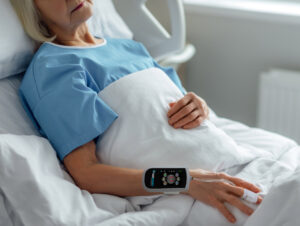
Vital sign measurement in hospital patients – how a wearable monitor can transform the patient experience
The most common intervention performed in hospitals is the measurement of vital signs. While nurses are confident about their ability to gather and interpret the data needed to identify patients at risk of deterioration, there are concerns about the frequency of observation and at times the accuracy of vital sign measurements.
A continuous, wearable vitals monitor could transform this aspect of critical care, affording patients greater comfort and less stress, while providing their clinical team with accurate, real-time information from anywhere in the hospital. Nurses will be able to spend more time using their observational skills at the bedside, while doctors will be able to intervene sooner when signs of deterioration are detected.
As we will see, this is a far cry from the way vital signs monitoring is implemented today.
A confusion of contraptions
A patient rushed into the emergency room will typically be met with a crowd of doctors and nurses, all checking for indications of their condition. One will place a cuff on the patient’s arm to measure blood pressure; another will clip an oximeter on their finger to measure blood oxygen. A nurse will hold their wrist and count their pulse against the ticking of a fob watch; another will poke a thermometer in their ear or under their tongue to get a temperature reading.
The patient lies there amidst this frenzy of activity, waiting for the treatment to start. Meanwhile, the vital signs data needs to be recorded and then keyed into a computer, before doctors can complete their assessment.
Not only is this assessment a traumatic and uncomfortable experience for the patient, it does not provide continuous and ongoing insights and takes up vital time too. Five minutes is the average time for spot-check vital signs to be recorded. In critical care, every second counts.
A wearable vitals monitor recording all five vital signs would make life so much easier for medical staff too. There would be no wires and tubes getting in the way, no colleagues crowding the patient – and the continuous data would be available to analyze in seconds rather than minutes.
Blind spots in the monitoring continuum
Once a patient has been stabilized and moved to the intensive care unit (ICU) for observation, further investigations are usually required, which involve transporting the patient to other parts of the hospital. An MRI scan or an x-ray, for example, will have to be carried out in the relevant scanning department.
This means detaching the patient from the monitors in the ICU, creating gaps in their continuous monitoring. As far as their care team is concerned, the patient effectively “goes dark” while they are being moved between departments. If there is a wait for the scanner, or it takes a long time (MRIs can take over an hour), it leaves the patient vulnerable for long periods when their vital signs could be deteriorating.
A wearable vitals monitor would remove this risk, staying with the patient wherever they go around the hospital and continuously relaying vitals data to the central hospital system. Should there be any sign of deterioration, doctors can be alerted immediately and necessary action taken.
Intermittent monitoring beyond the ICU
Once a patient is considered to be stable enough to leave the ICU, they will be moved to a room or a ward where their vitals will continue to be monitored, but only every four-to-six hours. Studies show that post-operative patients are still at risk in the days after leaving the ICU. For example, the incidence of acute hypotension in cardiac surgery patients increases in the days following surgery and is a leading cause of severe cardiac events.
The practicalities and expense of continuous vitals monitoring, as implemented in the ICU, mean that patients receive only intermittent monitoring once they are moved to the wards. This leaves them vulnerable to deteriorations going undetected, sometimes for hours, and this has been shown to place patients at risk.
By fitting the patient with a wearable vitals monitor throughout their hospital stay, monitoring blind spots are removed and any deterioration occurring in the days following their release from critical care will be picked up just as quickly as it would be in the ICU.
Ambulatory blood pressure monitoring
Continuous, non-invasive blood pressure monitoring offers major benefits for the care of chronic hypertensive patients too. It has long been recognized that for doctors to manage hypertension effectively, blood pressure readings need to be taken over a 24-hour period. This helps to rule out anomalies, such as ‘white coat hypertension’ (when anxiety induced by the medical setting causes a rise in blood pressure) and ‘masked hypertension’ (high blood pressure that doesn’t show up in the doctor’s surgery), and monitors the patient throughout a range of activities, from sleep to exercise.
The evolution of wearable beat-by-beat blood pressure monitors is enabling doctors to derive a much more accurate picture of their patients’ blood pressure readings in everyday situations. As a result, treatments and prescriptions can be more accurately matched to each individual patient, leading to the better ongoing management of their condition.
Availability and accuracy of data
Access to information is crucial in delivering positive patient outcomes. The accuracy and immediacy of that information affects doctors’ ability to make timely and appropriate decisions, which, in the critical care environment, can be the difference between life and death.
Continuous, wearable vitals monitors have the potential to improve patient experience and outcomes and make the work of nurses and doctors less complicated and cumbersome. The adoption of wearable monitors and automation is needed to streamline the delivery of hospital care in order to meet the ever-increasing demands of today’s healthcare system.
For more information on wearable vitals sign monitors, contact Caretaker on +1 434-978-7000
More medical news and events

Caretaker Medical Receives Inaugural Healthcare Tech Innovation Award and $200,000 Grant from Medical Society of D.C.
WASHINGTON, DC, UNITED STATES, April 2, 2025 /EINPresswire.com/ -Caretaker Medical is honored to announce it has been awarded the Healthcare Technology Innovation Award, along with…

Caretaker Medical Awarded the Grand Prize in NIH RADx Tech for Maternal Health Challenge
Caretaker Medical, a digital health company focused on developing hemodynamic monitoring devices, today announced that it has been awarded the $525,000 grand prize in the…

VitalStream offers continuous hemodynamic monitoring solution amid IV fluid shortage
Philadelphia, PA – October 9, 2024 – Caretaker Medical, a pioneer in advanced hemodynamic monitoring technology, is highlighting the critical role of its VitalStream solution…
